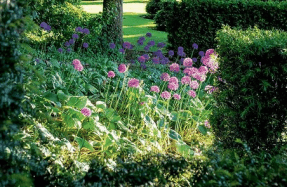

Sue Martin’s quarter-of-an-acre cottage garden at her nursery in Kent has been home to her Plant Heritage collection of geums – more than one hundred different cultivars and varieties – since 2006. “I was first attracted by their clear colours and variety,” says Sue. “They flower at a very good time of the year, when the spring flowers have finished but the summer extravaganza is yet to get going. They grow in all sorts of conditions, from shade to semi-shade to sun, and they flower for a very long time.”
Sue moved here in 1988 when the garden was a completely blank canvas because the previous owner had grown only vegetables. “The soil was fantastic because the man who lived here also worked on the farm. When he limed






